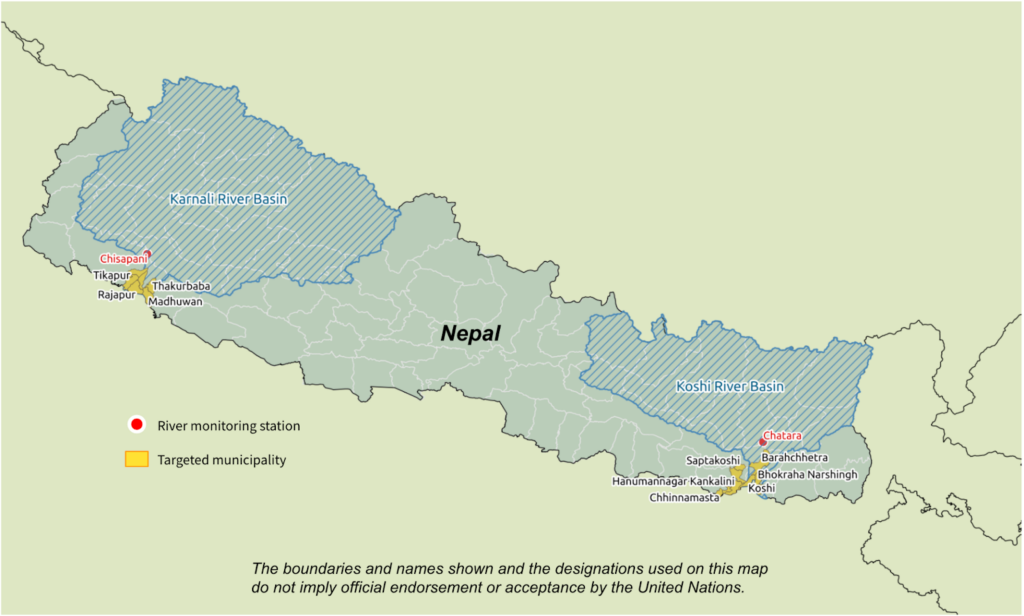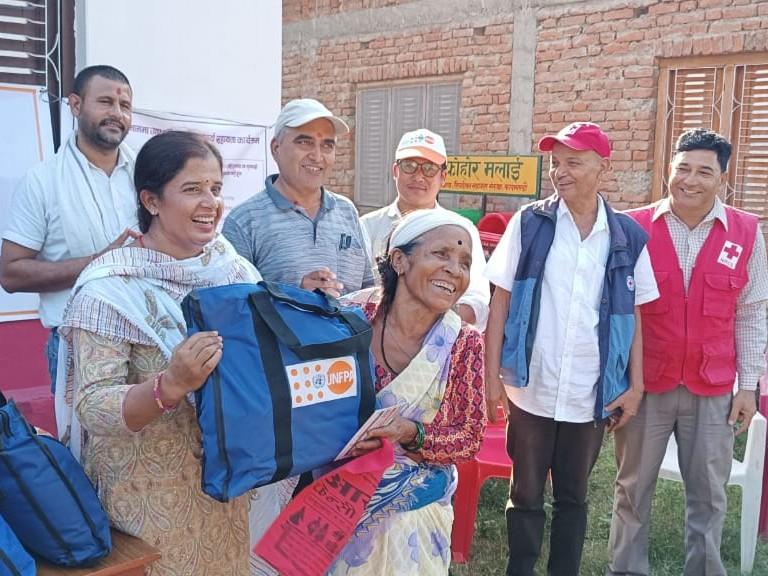Share
Nepal’s topography and climate make it vulnerable to intense flooding, particularly during its June-September monsoon season. Monsoon precipitation in Nepal is expected to increase 15-20 percent by 2050, with predictions of more frequent and severe flooding due to climate change. To help the most vulnerable flood-prone households meet their essential needs, the Centre supported OCHA and partners in implementing an anticipatory action framework for monsoon flooding. The Centre’s role was to develop the trigger mechanism for when to release funds and take action. The framework was agreed in 2021, activated in October 2022 and its extension for the 2023 monsoon season is currently being discussed.
Anticipatory action enables humanitarian organizations to get ahead of a shock and mitigate its impact on lives and livelihoods. In the event of heavy flooding, the Nepal anticipatory action framework aims to reach over 80,000 people in the downstream areas of the Karnali and Koshi river basins with cash and relief packages. The implementation partners include UNFPA, UNICEF, UN Women, WFP, WHO, as well as government partners, the Nepal Red Cross Society and national NGOs.
The framework uses forecasts from the Global Flood Awareness System (GloFAS) and the Nepal Department of Hydrology and Meteorology (DHM) to create a go/no-go trigger system. Once triggered, the UN Central Emergency Response Fund (CERF) would automatically release up to $6.7 million according to a pre-agreed plan.

Monsoon Flooding Trigger Development
A trigger for anticipatory action should be based on a set of criteria to help answer the questions when and where to act before an imminent disaster. It should forecast when a hazard risks becoming an out-of-the-ordinary (or severe) shock and where the humanitarian impact is likely to cross a certain threshold for the exposed vulnerable community.
There are two main challenges in developing a trigger for flooding: typically flood models can only provide a maximum of about one or two weeks of advance warning; and there is an inverse correlation between the reliability of flood warnings and the amount of warning time (i.e., the earlier the warning, the less reliable it tends to be).
The Nepal trigger mechanism is divided into two components referred to as ‘readiness’ and ‘action’ triggers. This approach provides agencies with the maximum window of opportunity to deliver anticipatory action on a no regrets basis, and builds on the lessons learned of the 2020 anticipatory action framework for monsoon flooding in Bangladesh.
The readiness trigger relies on the GloFAS forecast and is reached when the GloFAS 7-day forecast predicts a 70 percent likelihood of river discharge exceeding a 1-in-2 year return period level (a 1-in-2 year return period level is a river discharge level expected to be reached or exceeded once every 2 years). Once this threshold is met, CERF disburses the pre-agreed amount to the responding agencies. Around three percent of the total amount can be spent by partners for dispatching supplies, disseminating early warning messages and coordinating with local authorities. However, the bulk of the CERF funds can only be used when the threshold for the second component, the action trigger, is reached.
The action trigger has two conditions that must be met: an alert by the DHM; and either the probability of the GloFAS 3-day forecast predicts a 70 percent likelihood of river discharge exceeding a 1-in-2-year return period, or the height of the river exceeding the Government’s pre-defined danger level. Once these thresholds are surpassed, the responding agencies are able to use the remainder of the pre-agreed funding for humanitarian activities.
To develop the threshold for trigger activation, the Centre team analysed historical water level data from monitoring stations to identify historical flood events. We then used this analysis to evaluate the accuracy of the available past flood forecasts. We also looked at historical data from GloFAS to understand when the trigger would have been reached in the past, how many false alarms or missed activations would have occurred and how the performance of the forecast varies with lead time. From these findings, we determined the risk incurred by using these forecasts and the appropriate threshold levels for each trigger.
However, as with all trigger systems, there are limitations. Due to the challenging nature of forecasting river discharge in Nepal, only a fraction of GloFAS 1-in-2 year return period exceedance events are expected to be correctly forecasted with 4-7 days lead time (about 70 percent at Chatara, while at Chisapani the historical forecast has never reached this threshold for such long lead times). The implication is that this framework has a non-negligible probability of reaching the action trigger directly without a readiness trigger first. This would not impact the amount of funding that CERF would release, nor would it affect the plan of pre-agreed activities. Some of the activities would simply have to be implemented on shorter lead times.

Activating the Framework
On 2 October 2022, the GloFAS forecast readiness trigger threshold was reached for the Karnali basin and CERF released $3.2 million in funding for humanitarian activities. Humanitarian agencies used a small portion of this funding ($90,000) to communicate early warning messages, dispatch supplies to forward staging warehouses and coordinate with local authorities. On 7 October 2022, the action trigger threshold was reached, with the GloFAS forecast estimating a risk of flooding within the next three days, and the DHM releasing a bulletin warning of flooding in the target region. The chart above shows the evolution of the water level at Chisapani as measured by the DHM, with the peak occurring on 9 October.
As the action trigger was reached, agencies were able to use the remainder of the funding to disperse pre-approved cash and relief assistance such as hygiene kits and water purification tablets and provide services such as legal and psycho-social counselling. A preliminary report suggests that the responding agencies were able to reach over 71,000 people. A full impact assessment is currently underway and a more detailed report should be available later in 2023.

Monitoring and Improving the Trigger
The use of the CERF flood trigger model goes beyond anticipatory action, as it helps to better inform other existing emergency response plans already in place and increases the use of flood forecasts in emergency response. Discussions on the amount of funding available for anticipatory action in Nepal are ongoing. The Centre is working with local partners to monitor flood data for the current 2023 season, with the risk of peak flooding in July and August. We are also working to improve the trigger by incorporating historical flooding data, such as flood extent based on satellite imagery. This will help us to understand the link between prior floods and their humanitarian impact, and better predict the impact of a future flood.
Beyond Nepal, we are increasing our collaboration with local and national meteorological offices and agencies to use their water level and discharge historical data as well as forecasts to build upon and improve anticipatory action triggers for flooding. As we look at scaling up anticipatory action for floods, the learnings from the Nepal trigger, which combines globally-available models with local data and national early warning systems, will be crucial for understanding how different systems and tools can work together to maximize the lead time for action.
The Centre’s analysis can be found on GitHub, and the GloFAS data for Nepal can be downloaded using AnticiPy.